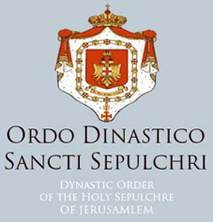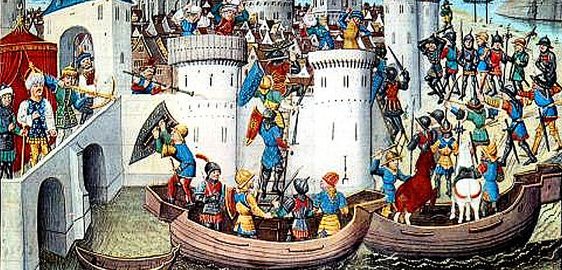


Section I:
THE Crusaders
Crusaders take their name from the Latin word “Crux” (a Cross) the crusaders badge. Tradition seems to prefer to pin their origin to Constantine the Great (Flavius Valerius Constantinus, c.280 – 337) the first Christian Emperor of Rome. Constantine, however, is chiefly renowned for his support of Christianity. Attributing his victory of the MILVIAN BRIDGE to a vision of the cross, seen before the battle, he adopted the monogram of Christ on his standard (LABORUM) and on the uniforms of his armies. Hence, the name Crusades (crossed). Later his mother the Empress Helena (c.250 – 330) who became a Christian during Constantine’s youth, and as the Emperor’s mother was very influential protectress of the Christian Church. In 326, she founded the basilicas of the Mount of Olives and at Bethlehem. The tradition that she discovered at Golgotha the Cross on which Christ was crucified dates from 395.
The crusaders were formed into a special force to protect these places especially the Holy Sepulchre. Later crusades were expeditions against the Moslems of the Holy Land, the first aimed at the recapture of Jerusalem, taken by the Seljuk Turks, popularly known as Saracens, in 1087. The desire of many, to make a pilgrimage to Jerusalem (which the Seljuks refused to allow) and the appeals from the Byzantine emperors for help in reconquering their lost provinces. The success of the wars against the Moslems in Spain and Italy, and the initiative of the papacy, were the main causes of the first Crusade. The desire of the Frankish princes to gain territory in Palestine, and of the Italian cities to develop their trade with the east became increasingly important.
Pope Urban II proclaimed the first crusade at the council of CLERMONT in 1095, and itinerant preachers such as Peter the Hermit roused crusading fervour.The disorderly bands that set off in 1096 achieved nothing and were mostly slaughtered in Asia Minor. But the well armed feudal armies that followed, in which France had the largest share, captured Jerusalem in 1099, and three principalities of independent foundation but which late became its fiefs, Tripoli, Antoich and Edessa. (Newnes Popular Encyclopedia).
At this point it is important to have a parenthesis:
Tradition shows that during the times we are discussing, there were other organisations, mostly known as Orders. For example, the Order of St. Catherine of Mount Sinai (which had a military character) who looked after the defence of the Sanctuary and the holy relics of the Saint, and the protection of the Pilgrims against the Moslems, from Jerusalem to Mount Sinai. “Ces Chevaliers – wrote Perrot – avaint la Regle de Saint Basile e’ le Memes Institutions que le Chevaliers du Saint Sepulcre” (Bascape’, G.C. L’Ordine Sovrano di Malte e gli Ordini Equestri della Chiesa part III page 176.
It is proper to say that the Order of the Holy Sepulchre, mentioned by Perrot, had exactly the same prerogatives of the Order of St. Catherine with one difference: “They protected the Holy Sepulchre of Christ”. Other Knights of such Orders as those of St. Catherine of Mount Sinai and of the Holy Sepulchre namely the Templars and the Hospitaliers, who combined military prowess with religious vows, helped to maintain these states, but Edessa fell in 1144.
St. Bernard preached the second crusade, and expeditions set out under Louis VII of France and the western emperor Conrad III but were defeated in Asia Minor. The third Crusade was the Christian response to the capture of Jerusalem in 1187 by Saladin, who had built up a powerful Moslem confederacy. The western emperor Frederick Barbasossa led an overland expedition (1189) but was drowned crossing a river in Asia Minor. Philip Augustus of France and Richard I of England (son of Henry II – 1190) who was crowned Defender of the Holy Sepulchre, came by sea, but though Acre was taken, quarrels developed between the leaders and Philip soon returned. Richard, who remained to fight it out with Saladin, obtained the cession of the entire coast towns and the permission for the pilgrims to visit Jerusalem. Trying to make his way home across Germany he was imprisoned and held at ransom.
From the beginning, the crusades had been on bad terms with the Byzantine emperors. As possible allies in the restoration of the lost coastal imperial lands, the crusaders, bent on carving out principalities for themselves had proved a sad disappointment. The crusaders too had felt chagrin at the lack of support by the one Christian power in the Near East. But Christendom was shocked when the forth crusade was diverted to Byzantine territory on the flimsiest of pretexts. Constantinople was stormed in April 1204 and a Latin empire, under Baldwin of Flanders established. By this time the crusading spirit was all but dead. But not the spirit of the chivalric Orders bound by their monastic rules.
The western emperor Frederick II did indeed succeed (1228 –29) in regaining Jerusalem but by treaty with the Moslem rulers of Egypt rather then as a knight of the cross.Later expeditions acomplished little or nothing and one after another the territories remaining to the crusaders passed into the Moslems hands. Jerusalem was again seized in 1244, Antioch lost in 1268, and Acre, the last Christian colony in Syria, fell in 1291. (Newnes Popular Encyclopaedia Vol.3, p. 847-8).
Read More...
Section II: Order of the Holy Sepulchre.
